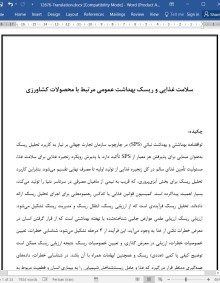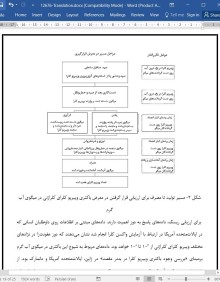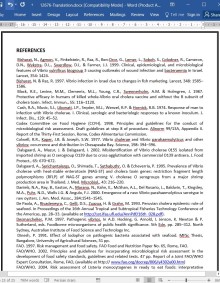
دانلود مقاله سلامت غذایی و ریسک بهداشت عمومی مرتبط با محصولات کشاورزی
چکیده:
توافقنامه بهداشتی و بهداشت نباتی (SPS) در چارچوب سازمان تجارت جهانی بر نیاز به کاربرد تحلیل ریسک بهعنوان مبنایی برای پذیرفتن هر معیار از SPS تأکید دارد. با پذیرش رویکرد زنجیره غذایی برای سلامت غذا، مسئولیت تأمین غذای سالم در کل زنجیره غذایی از تولید اولیه تا مصرف نهایی تقسیم میشود. بنابراین کاربرد تحلیل ریسک برای بخش آبزیپروری، که قریب به نیمی از ماهیان مصرفی در سرتاسر دنیا را تولید میکند، بسیار اهمیت پیداکرده است. کمیسیون قوانین غذایی یا کدکس رهنمودهایی برای اجرای تحلیل ریسک ارائه دادهاند. تحلیل ریسک فرآیندی است که از ارزیابی ریسک، انتقال ریسک و مدیریت ریسک تشکیل میشود. ارزیابی ریسک ارزیابی علمی عوارض جانبی شناختهشده یا نهفته بهداشتی است که از قرار گرفتن انسان در معرض خطرات ناشی از غذا به وجود میآید. این فرآیند از 4 مرحله تشکیل میشود: شناسایی خطرات، تعیین خصوصیات خطرات، ارزیابی در معرض گذاری، و تعیین خصوصیات ریسک. نتیجه ارزیابی ریسک ممکن است توضیح کیفی یا کمی (عددی) ریسک و همچنین ابهامات همراه با آن باشد. در شناسایی خطرات، دادههای همهگیری مدنظر قرار میگیرد که غذا و عامل زیستشناختی/شیمیایی را به بیماری انسان و قطعیت مربوط به این اثرات ربط میدهند. در مرحله تشخیص خطرات، شرح کیفی یا کمی از شدت و مدت اثرات سوء سلامت داده میشود که ممکن است از بلع آلایندههای میکروارگانیسم/سم/شیمیایی ناشی شوند. طی ارزیابی در معرض قرارگیری، برآوردی از تعداد باکتریها یا سطح سموم زیستی یا عامل شیمیایی مصرفشده از طریق غذای مربوطه انجام میشود. کدکس مرحله شناسایی مشخصات مواد شیمیایی را بهعنوان فرآیند تعیین برآورد کیفی و یا کمی ازجمله ابهامات همراه با احتمال پیشامد و شدت اثرات سوء شناختهشده یا نهفته در جمعیتی معین بر مبنای شناسایی زیان، ارزیابی در معرض قرارگیری و تعیین خصوصیات زیان تعریف میکند. بهعنوان نمونهای از ارزیابی ریسک، ارزیابی سازمان غذا و کشاورزی ملل متحد / سازمان سلامت جهانی از ریسک بیماری ویبریو کلورای کولراژنی در میگوی آب گرم در تجارت بینالمللی بیان میشود. مدیریت ریسک، فرآیند انتخاب جایگزینهای دیگر سیاست وزنکشی در پرتو نتایج ارزیابی ریسک، و در صورت لزوم انتخاب و اجرای گزینههای مناسب کنترل ازجمله معیارهای قانونی است. انتقال ریسک فرآیندی تعاملی از تبادل اطلاعات و نظر در زمینه ریسک بین ارزیابان ریسک، مدیران ریسک و سایر طرفهای ذینفع است. مثالهایی از معیارهای مدیریت ریسک که بر اساس ارزیابی ریسک انتخابشدهاند، ارائه میشوند.
مقدمه
فجایع بیماریهای ناشی از غذا همچنان مسئله مهمی در سرتاسر دنیاست، و تجارت بینالمللی محصولات غذایی در حال افزایش است. طبق برآوردهای سازمان سلامت جهانی (WHO) هرسال 8 /1 میلیون مرگومیر مربوط به غذا یا آب آلوده اتفاق میافتد. از قدیم برنامههای سلامت غذا، بهجای رویکرد پیشگیرانه، روی مکانیسمهای اجرا برای محصولات نهایی و حذف غذاهای ناسالم از بازار متمرکزشدهاند. در چنین مدلی، مسئولیت غذای سالم بر بخش فرآوری غذا متمرکز است. سازمان غذا و کشاورزی ملل متحد (FAO) رویکرد زنجیره غذایی را توصیه میکند که کل زنجیره غذایی از تولید اولیه گرفته تا مصرف نهایی را در برمیگیرد. در چنین سیستمی، مسئولیت تأمین غذای سالم، بهداشتی و مغذی بین کل زنجیره غذایی توسط تمام موارد دخیل در تولید، فرآوری، تجارت و مصرف غذا تقسیم میشود. سهامداران در این سیستم شامل کشاورزان، ماهیگیران، عمل آورندگان، عاملان حملونقل (مواد خام و فرآوری شده) و مصرفکنندگان و همچنین دولتهای متعهد به حفاظت از سلامت عمومی میشوند. بهمنظور حفاظت از سلامت عمومی و تسهیل تجارت بینالمللی غذا، کشورهای عضو سازمان تجارت جهانی (WTO) توافقنامه سلامت و سلامت نباتی (SPS) را امضا کردهاند. بر اساس این توافقنامه، کشورهای عضو حقدارند اقداماتی را انجام دهند تا مطمئن شوند که مصرفکنندگان از غذای سالم تأمین میشوند، اما آنها این وظیفه را نیز دارند که مطمئن شوند مقررات سلامت غذایی آنها برمبنای تحلیل ریسک است و اختیاری نیست و بهعنوان وسیلهای برای محافظت تولیدکنندگان داخلی از رقابت استفاده نمیشود. با توجه به اینکه قریب به 50 درصد از ماهی تجاری در بازارهای بینالمللی از آبزیپروری به دست میآید، کسب اطمینان از اینکه بخش آبزیپروری غذای سالم تولید میکند، امر مهمی است.
نتیجهگیری
سیستمهای سلامت غذایی بر اساس رویکرد تحلیل ریسک برای حفاظت از سلامت عمومی و ترویج تجارت بینالملل محصولات غذایی ازجمله محصولات آبزیپروری ضروری هستند. ارزیابی ریسک یک فرآیند مبتنی بر علم است و به دادههای قابلاطمینان نیاز دارد.
این ارزیابی شامل تخصص در زمینههای مختلف همچون تولید غذا (آبزیپروری)، میکروبشناسی، همهگیرشناسی، تکنیک فرآوری غذا و آمار و احتمالات میشود. بنابراین، در این ارزیابی در توافقنامههای WTOبه رسمیت شناختهشده بود. توافقنامه SPS بند کمکهای فنی به کشورهای عضو، بخصوص کشورهای درحالتوسعه، را توسط توافقنامههای دوجانبه و بهواسطه سازمانهای بینالمللی پیش میبرند. در توافقنامه SPS استانداردها و دستورالعملهای کدکس چونکه بیانگر اتفاق آراء بینالمللی است، پذیرفته میشود. بنابراین استانداردها کدکس بهعنوان محکی برای مقایسه معیارهایSPS ملی به کار گرفته میشوند. صندوق اعتماد FAO/WHO برای مشارکت در کدکس منابعی را فراهم میکند تا مشارکت کشورهای درحالتوسعه را در تعیین استاندارد کدکس بالا ببرد. استانداردها و امکانات توسعه تجارت (STDF) ابتکار مشترکی از بانک جهانی (WB)، FAO، سازمان جهانی سلامت حیوانات (OIE)، WHO و WTO که هدف آنها تقویت مشارکت اعطاکننده در تعیین استاندارد مربوط بهسلامت غذایی است. STDF کمکهای بلاعوض کوچکی برای پروژههای آزمونهای فراهم میکند که در تعیین استاندارد و توسعه در کشورهای درحالتوسعه ظرفیتسازی میکند. این رویکرد همچنین با دولت و بخش خصوصی در برآوردن استانداردهای بینالمللی همکاری میکنند و هماهنگسازی واسطهای و همکاری اعطاکننده در ارائه کمکهای فنی را ترویج میدهند. کشورهای درحالتوسعه میتوانند از این فرصتها برای تقویت توان خود در حوزه سلامت غذا و حفاظت از سلامت عمومی استفاده کنند.
ABSTRACT
The Sanitary and Phytosanitary (SPS) Agreement within the framework of the World Trade Organization emphasizes the need to apply risk analysis as a basis for taking any SPS measure. With the adoption of the food-chain approach for food safety, the responsibility for the supply of safe food is shared along the entire food chain from primary production to final consumption. Thus the application of risk analysis to the aquaculture sector, which produces nearly half the fish that is consumed worldwide, has become very important. Guidelines for performing risk analysis have been brought out by the Codex Alimentarius Commission or Codex. Risk analysis is a process consisting of risk assessment, risk communication and risk management. Risk assessment is the scientific evaluation of known or potential adverse health effects resulting from human exposure to foodborne hazards. This consists of four steps: hazard identification, hazard characterization, exposure assessment and risk characterization. The output of risk assessment may be a qualitative or a quantitative (numerical) expression of risk as well as attendant uncertainties. Hazard identification considers epidemiological data linking the food and biological/chemical agent to human illness and the certainty associated with such effects. At the hazard characterization step, a qualitative or quantitative description of the severity and the duration of the adverse health effect that may result from the ingestion of the micro-organism/toxin/chemical contaminants is made. During exposure assessment, an estimate of the number of bacteria or the level of a biotoxin or chemical agent consumed through the concerned food is made. The Codex defines the risk characterization step as the process of determining the qualitative and/or quantitative estimation including attendant uncertainties of the probability of occurrence and the severity of the known or potential adverse health effect in a given population based on hazard identification, exposure assessment and hazard characterization. As an example of a risk assessment, the Food and Agriculture Organization of the United Nations/World Health Organization risk assessment for choleragenic Vibrio cholerae in warmwater shrimp in international trade is presented. Risk management is the process of weighing policy alternatives in the light of the results of risk assessment and if required, selecting and implementing appropriate control options, including regulatory measures. Risk communication is an interactive process of exchange of information and opinion on risk among risk assessors, risk managers and other interested parties. Examples of risk management measures adopted based on risk assessment are presented.
INTRODUCTION
Outbreaks of food-borne illnesses continue to be a major problem worldwide, and international trade in food products is increasing. According to World Health Organization (WHO) estimates, 1.8 million deaths related to contaminated food or water occur every year. Traditionally, food safety programmes have focused on enforcement mechanisms for final products and removal of unsafe food from the market instead of a preventive approach. In such a model, the responsibility for safe food tends to concentrate on the food-processing sector. The Food and Agriculture Organization of the United Nations (FAO) is recommending a food-chain approach that encompasses the whole food chain from primary production to final consumption. In such a system, the responsibility for a supply of food that is safe, healthy and nutritious is shared along the entire food chain by all involved in the production, processing, trade and consumption of food. Stakeholders include farmers, fishermen, processors, transport operators (raw and processed material) and consumers, as well as governments obliged to protect public health. In order to protect public health and facilitate international food trade, the member countries of the World Trade Organization (WTO) have signed the Sanitary and Phytosanitary (SPS) Agreement. Under this agreement, member countries have a right to take measures to ensure that consumers are supplied with safe food, but they also have the obligation to ensure that their food safety regulations are based on risk analysis and are not arbitrary and used as a means to protect domestic producers from competition. Considering that nearly 50 percent of the fish traded in international markets comes from aquaculture, it is important to ensure that the aquaculture sector is producing safe food.
CONCLUSIONS
Food safety systems based on a risk analysis approach are essential to protect public health and promote international trade in food products, including products of aquaculture. Risk assessment is a science-based process and requires reliable data. It involves expertise in different fields such as food production (aquaculture), microbiology, epidemiology, food-processing technology and statistics. Thus, it requires both human and financial resources, and this could be one of the major constraints for developing countries. This has been recognized in WTO agreements. The SPS Agreement encourages the provision of technical assistance to member states, particularly developing countries, through bilateral agreements and via international organizations. SPS accepts Codex standards and guidelines as representing international consensus. Thus Codex standards serve as the benchmark for comparison of national SPS measures. The FAO/WHO Trust Fund for Participation in Codex provides resources to enhance developing-country participation in Codex standard setting. The Standards and Trade Development Facility (STDF) is a joint initiative of the World Bank (WB), FAO, the World Organisation for Animal Health (OIE), WHO and WTO that aims to strengthen donor contribution in standard setting related to food safety. STDF provides small grants for pilot projects that build capacity in standard setting and development in developing countries. STDF also provides assistance to government and the private sector in meeting international standards and promotes interagency coordination and donor collaboration in the delivery of technical assistance. Developing countries can make use of these opportunities to strengthen their capacity in the area of food safety and public health protection.
چکیده
مقدمه
فرآیند تحلیل ریسک
شناسایی مخاطرات
ارزیابی میزان در معرض قرارگیری
تعیین مشخصات مواد مضر و تحلیل واکنش به دوز
تعیین مشخصات ریسک
مدیریت ریسک
ارزیابی ریسک
ارزیابی گزینه ریسک
اجرای تصمیم مدیریت ریسک
نظارت و بازبینی
ملاحظات ثانویه از مدیریت ریسک
انتقال ریسک
ارزیابی ریسک FAO/WHO برای ویبریو کلرای کلراژنی در میگوی آب گرم در تجارت بینالملل: مثالی از ارزیابی ریسک
نتیجهگیری
منابع
ABSTRACT
INTRODUCTION
THE RISK ANALYSIS PROCESS
Hazard identification
Exposure assessment
Hazard characterization and dose-response analysis
Risk characterization
Risk management
Risk evaluation
Risk option assessment
Implementation of the risk management decision
Monitoring and review
Further risk management considerations
Risk communication
FAO/WHO RISK ASSESSMENT FOR CHOLERAGENIC VIBRIO CHOLERAE IN WARMWATER SHRIMP IN INTERNATIONAL TRADE: EXAMPLE OF A RISK ASSESSMENT
CONCLUSIONS
REFERENCES
- اصل مقاله انگلیسی با فرمت ورد (word) با قابلیت ویرایش
- ترجمه فارسی مقاله با فرمت ورد (word) با قابلیت ویرایش، بدون آرم سایت ای ترجمه
- ترجمه فارسی مقاله با فرمت pdf، بدون آرم سایت ای ترجمه



